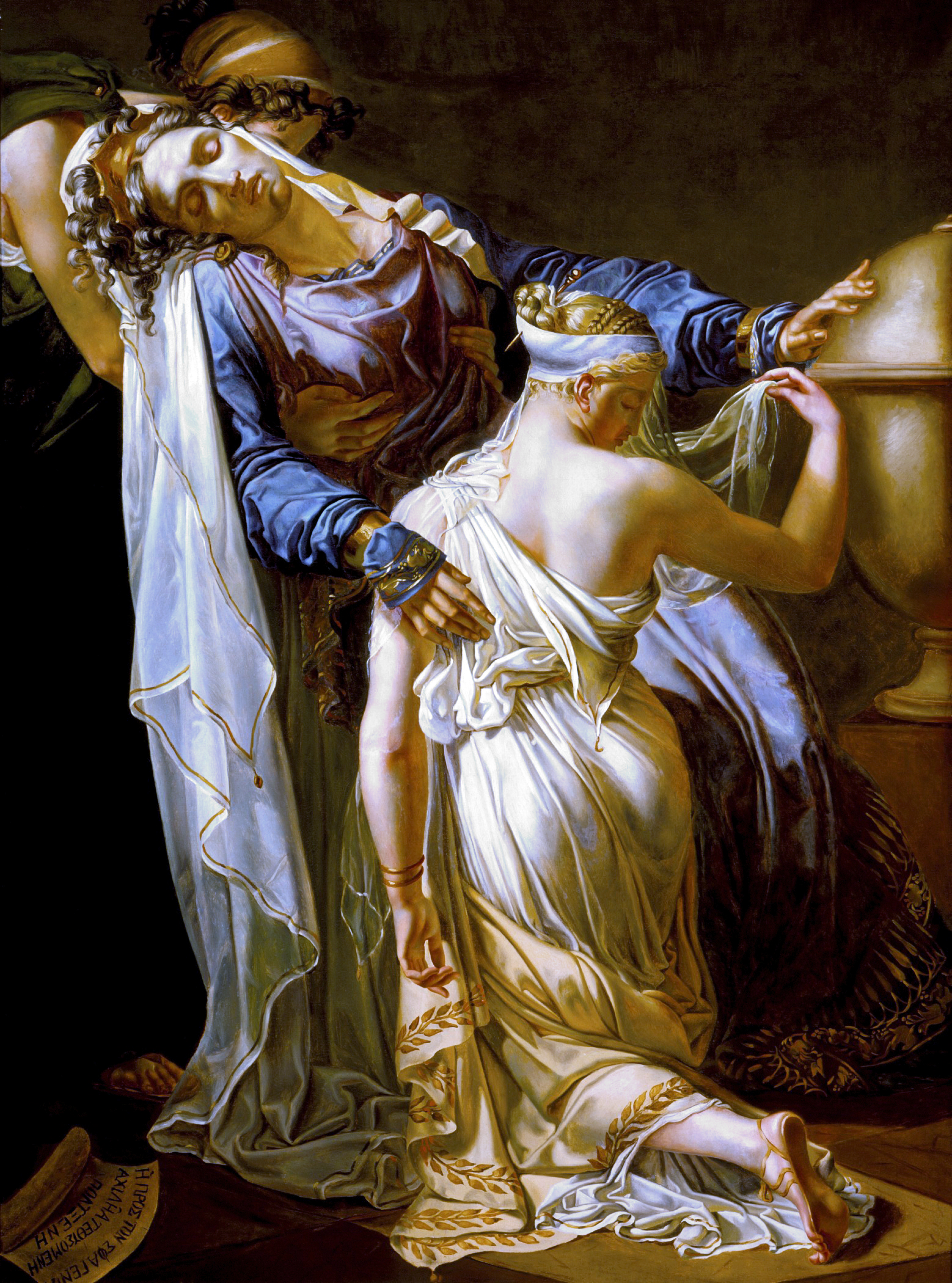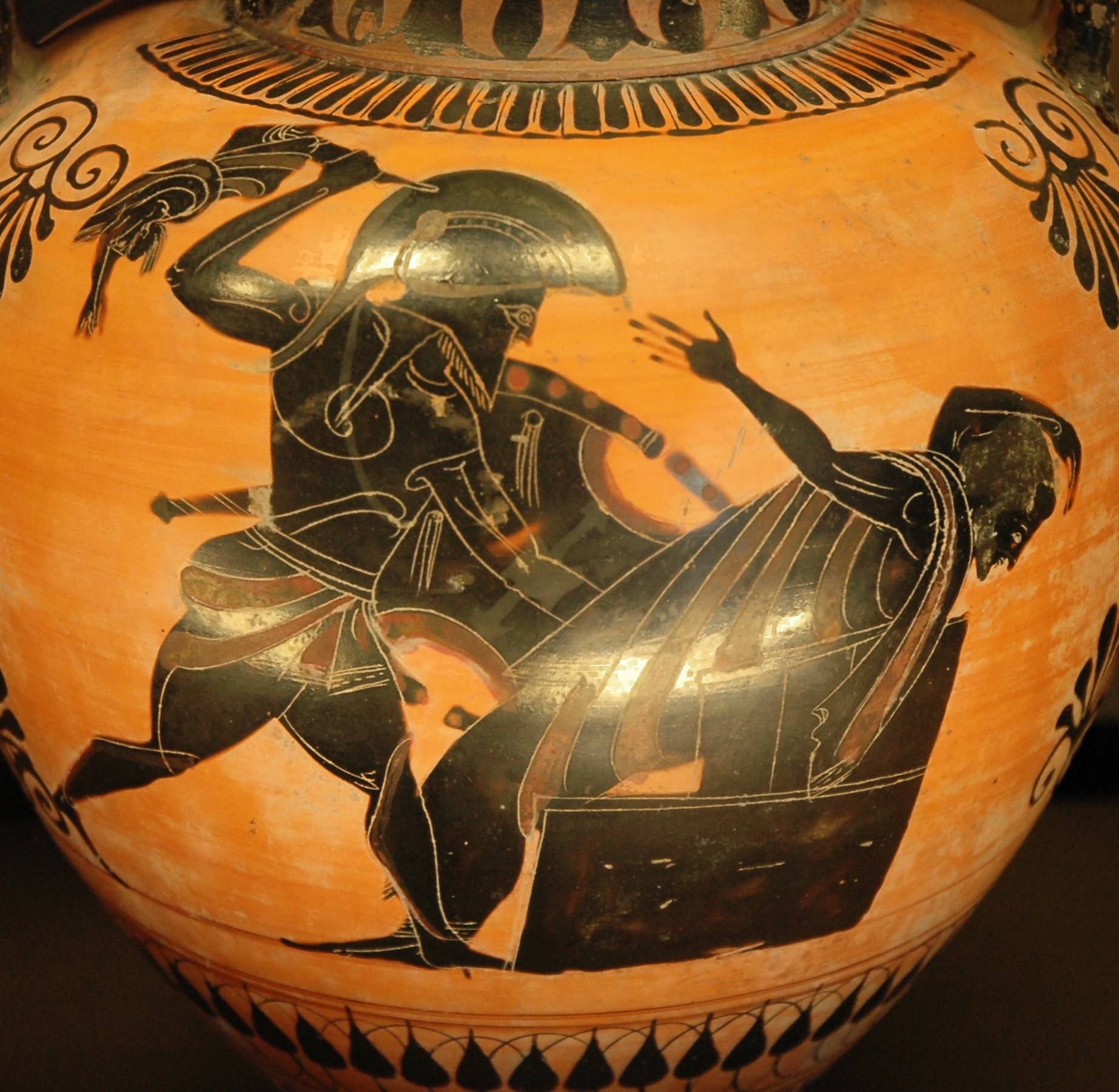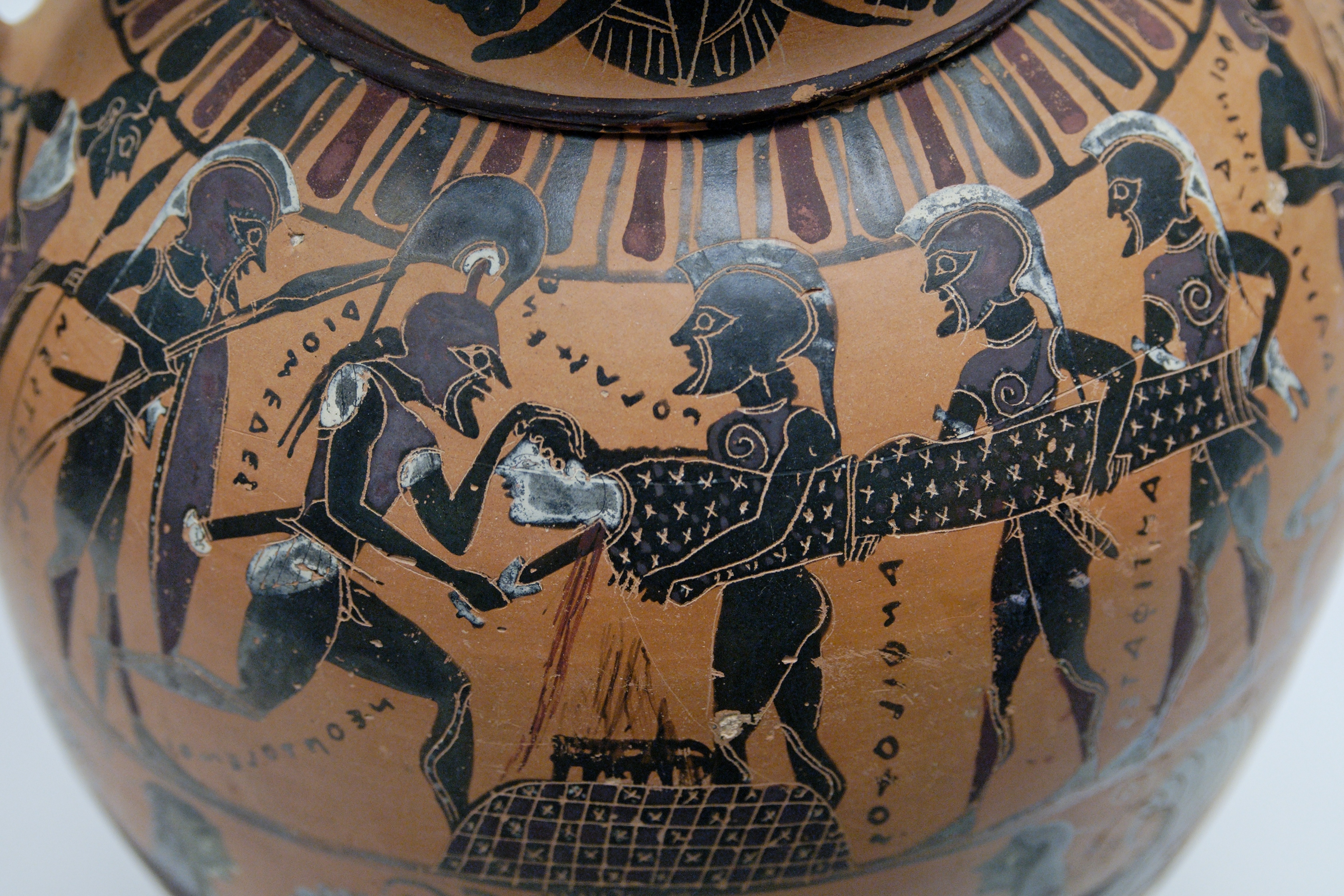|
Deiphobus
In Greek mythology, Deiphobus ( grc, , Dēḯphobos) was a son of Priam and Hecuba. He was a prince of Troy, and the greatest of Priam's sons after Hector and Paris. Deiphobus killed four men of fame in the Trojan War. Description Deiphobus was described by the chronicler Malalas in his account of the ''Chronography'' as " above average stature, keen-eyed, somewhat snub-nosed, dark-skinned, flat-faced, brave, good beard". Meanwhile, in the account of Dares the Phrygian, he was illustrated as ". . .looked like his father .e. a handsome face He was the man of forceful action". Mythology According to the ''Iliad'' (books XII, XIV, XXII), in the Trojan War Deiphobus, along with his brother Helenus, led a group of soldiers at the siege of the newly constructed Argive wall and killed many, and wounded the Achaean hero Meriones. As Hector was fleeing Achilles, Athena took the shape of Deiphobus and goaded Hector to make a stand and fight. Hector, thinking it was his brothe ... [...More Info...] [...Related Items...] OR: [Wikipedia] [Google] [Baidu] |
1867 Deiphobus
1867 Deiphobus is a dark Jupiter trojan from the Trojan camp, approximately in diameter. It was discovered on 3 March 1971, by Argentine astronomers Carlos Cesco and A. G. Samuel at the Leoncito Astronomical Complex in Argentina, and later named after the Trojan prince Deiphobus from Greek mythology. The dark D-type asteroid is one of the largest Jupiter trojans. It is a member of the Ennomos family and has a long rotation period of 58.66 hours. Orbit and classification ''Deiphobus'' is a dark Jovian asteroid orbiting in the trailing Trojan camp at Jupiter's Lagrangian point, 60 ° behind its orbit in a 1:1 resonance . It is a member of the Ennomos family (009), a small Jovian asteroid family with 30 known members, named after 4709 Ennomos. There only a few Jovian families known to date. The Ennomos family was first identified by Jakub Rozehnal and Miroslav Brož in 2011. However, a different HCM-based analysis assigns ''Deiphobus'' to the Jovian background popul ... [...More Info...] [...Related Items...] OR: [Wikipedia] [Google] [Baidu] |
Meriones (mythology)
In Greek mythology, Meriones ( grc, Μηριόνης, Mēriónēs) was the Cretan son of Molus and Melphis or Euippe. Molus was a half-brother of Idomeneus. Like other heroes of mythology, Meriones was said to be a descendant of gods. As a grandson of Deucalion (son of Minos), Meriones' ancestors include Zeus, Europa, Helios, and Pasiphae, the sister of Circe. Meriones possessed the helmet of Amyntor, which Autolycus had stolen. He inherited the helmet from his father Molus and later gave it to Odysseus. Meriones killed seven men at Troy. Description Meriones was described by the chronicler Malalas in his account of the ''Chronography'' as "shortish, wide, white, good beard, big eyes, black hair, curly hair, flat face, bent nose, quick-moving, magnanimous, a warrior". Meanwhile, in the account of Dares the Phrygian, he was illustrated as ". . . auburn-haired, of moderate height, with a well-proportioned body. He was robust, swift, unmerciful, and easily angered." Mytho ... [...More Info...] [...Related Items...] OR: [Wikipedia] [Google] [Baidu] |
Helen Of Troy
Helen of Troy, Helen, Helena, (Ancient Greek: Ἑλένη ''Helénē'', ) also known as beautiful Helen, Helen of Argos, or Helen of Sparta, was a figure in Greek mythology said to have been the most beautiful woman in the world. She was believed to have been the daughter of Zeus and Leda, and was the sister of Clytemnestra, Castor and Pollux, Philonoe, Phoebe and Timandra. She was married to King Menelaus of Sparta "who became by her the father of Hermione, and, according to others, of Nicostratus also." The usual tradition is that after the goddess Aphrodite promised her to Paris in the Judgement of Paris, she was seduced by him and carried off to Troy. This resulted in the Trojan War when the Achaeans set out to reclaim her. Another ancient tradition, told by Stesichorus, tells of how "not she, but her wraith only, had passed to Troy, while she was borne by the Gods to the land of Egypt, and there remained until the day when her lord Menelaus, turning aside on the hom ... [...More Info...] [...Related Items...] OR: [Wikipedia] [Google] [Baidu] |
Hector
In Greek mythology, Hector (; grc, Ἕκτωρ, Hektōr, label=none, ) is a character in Homer's Iliad. He was a Trojan prince and the greatest warrior for Troy during the Trojan War. Hector led the Trojans and their allies in the defense of Troy, killing countless Greek warriors. He was ultimately killed in single combat by Achilles, who later dragged his dead body around the city of Troy behind his chariot. Etymology In Greek, is a derivative of the verb ἔχειν ''ékhein'', archaic form * grc, ἕχειν, hékhein, label=none ('to have' or 'to hold'), from Proto-Indo-European *'' seɡ́ʰ-'' ('to hold'). , or as found in Aeolic poetry, is also an epithet of Zeus in his capacity as 'he who holds verything together. Hector's name could thus be taken to mean 'holding fast'. Description Hector was described by the chronicler Malalas in his account of the ''Chronography'' as "dark-skinned, tall, very stoutly built, strong, good nose, wooly-haired, good beard, sq ... [...More Info...] [...Related Items...] OR: [Wikipedia] [Google] [Baidu] |
Helenus
In Greek mythology, Helenus (; grc, Ἕλενος, ''Helenos'', la, Helenus) was a gentle and clever seer. He was also a Trojan prince as the son of King Priam and Queen Hecuba of Troy, and the twin brother of the prophetess Cassandra. He was also called Scamandrios, and was a lover of Apollo. Mythology Early years In the earliest sources, Helenus and his sister Cassandra were given the power of prophecy by Apollo after their ears were licked by snakes. In other sources, Helenus was taught the power by Cassandra, but others generally believed his predictions. After gaining foresight, he was renamed from Scamandrius to Helenus by a Thracian soothsayer. Helenus predicted that if Alexander (Paris) brought home a Greek wife (i.e. Helen), the Achaeans would pursue, and overpower Troy and slay his parents and brothers. Trojan War Helenus is described by Homer as being the greatest of augurs. He advises Hector to challenge any Achaean to a duel, which Telemonian Ajax ac ... [...More Info...] [...Related Items...] OR: [Wikipedia] [Google] [Baidu] |
Hecuba
Hecuba (; also Hecabe; grc, Ἑκάβη, Hekábē, ) was a queen in Greek mythology, the wife of King Priam of Troy during the Trojan War. Description Hecuba was described by the chronicler Malalas in his account of the ''Chronography'' as "dark, good eyes, full grown, long nose, beautiful, generous, talkative, calm". Meanwhile, in the account of Dares the Phrygian, she was illustrated as ". . .beautiful, her figure large, her complexion dark. She thought like a man and was pious and just." Family Parentage Ancient sources vary as to the parentage of Hecuba. According to Homer, Hecuba was the daughter of King Dymas of Phrygia, but Euripides and Virgil write of her as the daughter of the Thracian king Cisseus. The mythographers Pseudo-Apollodorus and Hyginus leave open the question which of the two was her father, with Pseudo-Apollodorus adding a third alternative option: Hecuba's parents could as well be the river god Sangarius and Metope. Some versions from non-extant ... [...More Info...] [...Related Items...] OR: [Wikipedia] [Google] [Baidu] |
Trojan War
In Greek mythology, the Trojan War was waged against the city of Troy by the Achaeans (Greeks) after Paris of Troy took Helen from her husband Menelaus, king of Sparta. The war is one of the most important events in Greek mythology and has been narrated through many works of Greek literature, most notably Homer's ''Iliad''. The core of the ''Iliad'' (Books II – XXIII) describes a period of four days and two nights in the tenth year of the decade-long siege of Troy; the '' Odyssey'' describes the journey home of Odysseus, one of the war's heroes. Other parts of the war are described in a cycle of epic poems, which have survived through fragments. Episodes from the war provided material for Greek tragedy and other works of Greek literature, and for Roman poets including Virgil and Ovid. The ancient Greeks believed that Troy was located near the Dardanelles and that the Trojan War was a historical event of the 13th or 12th century BC, but by the mid-19th century AD, both ... [...More Info...] [...Related Items...] OR: [Wikipedia] [Google] [Baidu] |
List Of Children Of Priam
In Greek mythology, Priam, the mythical king of Troy during the Trojan War, supposedly had 18 daughters and 68 sons. Priam had several wives, the primary one Hecuba, daughter of Dymas or Cisseus, and several concubines, who bore his children. There is no exhaustive list, but many of them are mentioned in various Greek myths. Almost all of Priam's children were slain by the Greeks in the course of the war, or shortly after. The three main sources for the names of the children of Priam are: Homer's ''Iliad'', where a number of his sons are briefly mentioned among the defenders of Troy; and two lists in the '' Bibliotheca'' and Hyginus' ''Fabulae''. Virgil also mentions some of Priam's sons and daughters in the ''Aeneid.'' Some of the daughters taken captive at the end of the war are mentioned by Pausanias, who in his turn refers to paintings by Polygnotus in the Lesche of Delphi. These are summarized by author below. Sons Daughters Pausanias enlists several more Trojan ... [...More Info...] [...Related Items...] OR: [Wikipedia] [Google] [Baidu] |
Priam
In Greek mythology, Priam (; grc-gre, Πρίαμος, ) was the legendary and last king of Troy during the Trojan War. He was the son of Laomedon. His many children included notable characters such as Hector, Paris, and Cassandra. Etymology Most scholars take the etymology of the name from the Luwian 𒉺𒊑𒀀𒈬𒀀 (Pa-ri-a-mu-a-, or “exceptionally courageous”), attested as the name of a man from Zazlippa, in Kizzuwatna. A similar form is attested transcribed in Greek as ''Paramoas'' near Kaisareia in Cappadocia. Some have identified Priam with the historical figure of Piyama-Radu, a warlord active in the vicinity of Wilusa. However, this identification is disputed, and is highly unlikely, given that he was known in Hittite records as being an ally of the Ahhiyawa against Wilusa. A popular folk etymology derives the name from the Greek verb , meaning 'to buy'. This in turn gives rise to a story of Priam's sister Hesione ransoming his freedom, with a golden vei ... [...More Info...] [...Related Items...] OR: [Wikipedia] [Google] [Baidu] |
Athena
Athena or Athene, often given the epithet Pallas, is an ancient Greek goddess associated with wisdom, warfare, and handicraft who was later syncretized with the Roman goddess Minerva. Athena was regarded as the patron and protectress of various cities across Greece, particularly the city of Athens, from which she most likely received her name. The Parthenon on the Acropolis of Athens is dedicated to her. Her major symbols include owls, olive trees, snakes, and the Gorgoneion. In art, she is generally depicted wearing a helmet and holding a spear. From her origin as an Aegean palace goddess, Athena was closely associated with the city. She was known as ''Polias'' and ''Poliouchos'' (both derived from '' polis'', meaning "city-state"), and her temples were usually located atop the fortified acropolis in the central part of the city. The Parthenon on the Athenian Acropolis is dedicated to her, along with numerous other temples and monuments. As the patron of craft an ... [...More Info...] [...Related Items...] OR: [Wikipedia] [Google] [Baidu] |
Achilles
In Greek mythology, Achilles ( ) or Achilleus ( grc-gre, Ἀχιλλεύς) was a hero of the Trojan War, the greatest of all the Greek warriors, and the central character of Homer's '' Iliad''. He was the son of the Nereid Thetis and Peleus, king of Phthia. Achilles' most notable feat during the Trojan War was the slaying of the Trojan prince Hector outside the gates of Troy. Although the death of Achilles is not presented in the ''Iliad'', other sources concur that he was killed near the end of the Trojan War by Paris, who shot him with an arrow. Later legends (beginning with Statius' unfinished epic '' Achilleid'', written in the 1st century AD) state that Achilles was invulnerable in all of his body except for one heel, because when his mother Thetis dipped him in the river Styx as an infant, she held him by one of his heels. Alluding to these legends, the term "Achilles' heel" has come to mean a point of weakness, especially in someone or something with an other ... [...More Info...] [...Related Items...] OR: [Wikipedia] [Google] [Baidu] |
Polyxena
In Greek mythology, Polyxena (; Greek: ) was the youngest daughter of King Priam of Troy and his queen, Hecuba. She does not appear in Homer, but in several other classical authors, though the details of her story vary considerably. After the fall of Troy, she dies when sacrificed by the Greeks on the tomb of Achilles, to whom she had been betrothed and in whose death she was complicit in many versions. Description Polyxene was described by the chronicler Malalas in his account of the ''Chronography'' as "tall, pure, very white, large-eyed, black-haired, with her hair worn long behind, a good nose and cheeks, blooming-lipped, small-footed, virgin, charming, very beautiful, 18 years old when they killed her". Meanwhile, in the account of Dares the Phrygian, she was illustrated as ". . .fair, tall, and beautiful. Her neck was slender, her eyes lovely her hair blond and long, her body well-proportioned, her fingers tapering, her legs straight, and her feet the best. Surpassing a ... [...More Info...] [...Related Items...] OR: [Wikipedia] [Google] [Baidu] |








